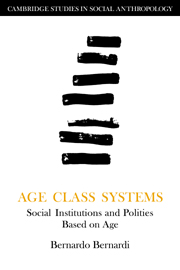Book contents
- Frontmatter
- Contents
- Translator's Preface
- Preface
- 1 Characteristics of age class systems
- 2 The anthropological study of age class systems
- 3 Legitimation and power in age class systems
- 4 The choice of ethnographic models
- 5 The initiation model
- 6 The initiation-transition model
- 7 The generational model
- 8 The residential model
- 9 The regimental model
- 10 The choreographic model
- 11 Women and age class systems
- 12 The ethnemic significance of the age class system
- 13 History and changes in age class systems
- Glossary
- References
- Index
1 - Characteristics of age class systems
Published online by Cambridge University Press: 29 September 2009
- Frontmatter
- Contents
- Translator's Preface
- Preface
- 1 Characteristics of age class systems
- 2 The anthropological study of age class systems
- 3 Legitimation and power in age class systems
- 4 The choice of ethnographic models
- 5 The initiation model
- 6 The initiation-transition model
- 7 The generational model
- 8 The residential model
- 9 The regimental model
- 10 The choreographic model
- 11 Women and age class systems
- 12 The ethnemic significance of the age class system
- 13 History and changes in age class systems
- Glossary
- References
- Index
Summary
The relativity of the age concept
To examine age class systems, we must evaluate a concept of age that is alien to our Western social tradition. In Western societies, we do not find such groupings of age mates, designed to govern the participation of individuals in social and political life. Age is employed conceptually to define certain categories of persons, but it is not used as a basis for constructing the societal structure. Groups of conscripts may, perhaps, exhibit some similarity, but here we are dealing with voluntary associations that are more or less temporary and are, in any case, used almost exclusively for recreational purposes.
In both current usage and in historical tradition, the Western concept of age seems ambiguous and fluid. At one time, for example, medieval medicine distinguished the physiological development of human beings into “climacterics,” or seven periods of seven years each. Today, no one views the life course in these terms. We celebrate birthdays, with happiness in childhood and with sadness in old age, but there are those who prefer to ignore them, or, indeed, to conceal their date of birth. We speak very broadly of a first, second, and third age, and we distinguish a series of grades that signal the passage from the one to the other, but without giving them too much weight.
- Type
- Chapter
- Information
- Age Class SystemsSocial Institutions and Polities Based on Age, pp. 1 - 10Publisher: Cambridge University PressPrint publication year: 1985

